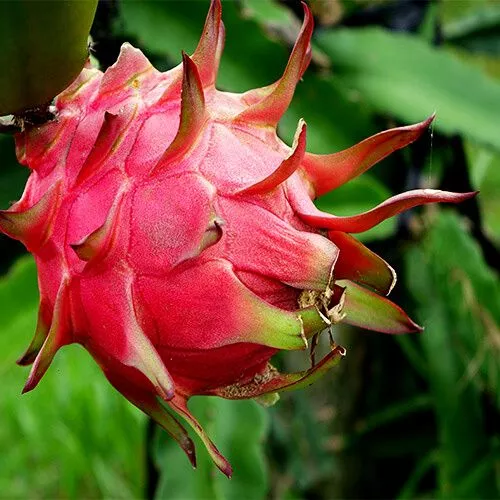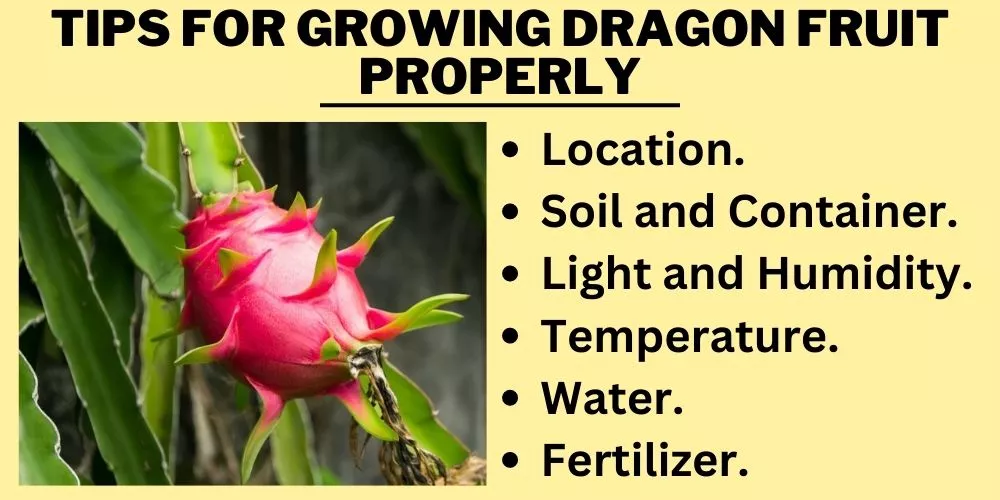It’s easy to mistake a Dog Tail Cactus and Dragon Fruit Cactus for one another as they share multiple commonalities. Especially when it comes to the way they look.
Understanding each of their distinguishing features and slightly different growing patterns will make identifying them a much easier task.
This article is to address the dog tail cactus vs dragon fruit confusion. It will help you identify the both properly.
The most prominent indicator is that the dragon fruit cactus bears bright pink fruit. The problem with this method of determining between the 2 is that the fruit won’t grow for quite some time once planted.
So we’re back to square one, at least until the 5 years from seed or 2 year from cutting wait is over, and the fruits begin to show up.
In this article, we’ll go through exactly how to tell the difference between the 2 plants from early on. Not only that, but we will offer some tips to help them grow unhindered!
Sound good? Alright, let’s do this!

Table of Contents
Dog Tail Cactus
The Dog Tail Cactus (A.K.A Pitaya De Tortuga) is a perennial cactus native to tropical South America and belongs to the Cactaceae family.
Often mistaken as a succulent, this vibrant green houseplant is popular amongst indoor garden enthusiasts due to its drought tolerant nature.
It can also be grown outdoors as long as the conditions that they are subject to being optimal. Its stems are broad at the base and progressively thinner towards the tip.

The stems contain fuzzy looking spines from base to tip. The stem’s form resembles a dog’s tail, hence the name. Dog tails can grow up to 9 feet (2.7 meters) in height. In their native habitat, the dog tail cactus grows in trees, similar to how air plants establish themselves.
Growing a dog tail cactus in a hanging basket can dramatically increase the growing area’s aesthetics. Mainly because they can grow in their natural behavior when using baskets.
Tips for Growing Dog Tail Cactus Properly
These plants can be tricky to grow and maintain if all of their requirements aren’t met. Let’s look at some simple tips to ensure your dog tail cactus plant has everything it needs to survive and thrive.

Location
It’s worth noting that this plant is a cactus, and its spines can cause pain and discomfort just by simply brushing by. Having them planted somewhere low could harm both humans and/pets. Ideally, it’s best to hang these plants up out of the way in a basket.
Furthermore, avoid hanging them in narrow walkways or thoroughfares where the protruding, dangly tails can whip unsuspecting heads or limbs.
Soil and Container
These types of plants need adequate drainage. Prepare a blend that includes both course and organic materials. A two-part grit mix using sand, vermiculite or gravel to one-part organic matter such as compost or rotting cow dung is perfect. This will assist with nutrients, drainage and aeration.
Try to aim for a pH of between 5.5 and 6.5. Terracotta containers are ideal as they are porous and further assist with drainage. The pot needs drainage holes if you don’t want to run into problems with root rot later down the track.
Light and Humidity
As dog tail cactus plants usually grow suspended in a tree or canopy in their natural habitat, we must try to mimic those conditions if possible. So hanging them somewhere that offers at least 6 hours of indirect sunlight per day with protective shade is optimal.
Some great areas include a tree branch, in an open garage or under a porch. Additionally, the dog tail grows best when subject to at least 50% humidity, so trying to mimic these conditions will see better long term growth results.
Temperature
Firstly, it’s worth noting that these plants grow from mid spring to late summer/early autumn. They thrive best in warmer temperatures but can suffer badly when subject to frost. The optimal growing temperatures of the dog tail cactus are between 40-90°F (4.4-32°C).
Depending on the growth location, it’s best to take these plants indoors during the colder months. If that isn’t possible, it may be worth considering some heat lamps or placing the plants away from cold winds. Eg, undercover, behind a windbreak, etc.
Water
These plants enjoy good watering, but like most cacti, you should use the soak and dry method. Soak the top 2 inches of soil and only apply more moisture once the top 2 inches have dried out completely. Additionally, the dog tail cactus likes to be misted to help increase the humidity.
Aim to water and mist earlier in the day to allow the plant to dry out during the afternoon. If water sits within the plant’s crevices during the night, mold can form, so it’s important to administer water at appropriate times.
Fertilizer
If the potting mix is prepared correctly, the available nutrients in the soil will offer enough food for the plant in the first year. Excess fertilization isn’t necessary. However, once the plant is established, a spray diluted fertilizer can be administered during its season of growth (late spring-early summer).
Dragon Fruit
The dragon Fruit Cactus (A.K.A Pitaya, Pithaya) is a perennial exotic cactus that belongs to the Cactaceae family. It has been cultivated in several different tropical and subtropical regions worldwide.
The main areas include Peru, Mexico, South East Asia, The Caribbean and Australia. This cactus is known more for its fruit, the dragon fruit.
The plant itself has broad, long, spiny, green vines. The spines are more spread out than those of the dog tail.

The vines grow from a rough, light brown trunk or stem. These types of cactus can grow as large as 35 feet (8 meters). The fruits usually don’t begin to grow until around 5 years if grown from seed or 2 years from a more mature cutting.
When fully grown, the dragon fruit produced has a vibrant pink colored skin with soft but wavy, green, dangling nodes/leaves. On the inside, the fruit itself is a beautiful white color with black spots/seeds.
The texture of the fruit is crunchy but sweet and tastes like a pear or kiwi. The fruit can be scooped out of the skin with a spoon.
Tips for Growing Dragon Fruit Properly
Growing a dragon fruit cactus to full maturity is no easy feat. It takes time and patience, but the fruits that it bears far outweigh the nurturing efforts. Let’s look at the optimal requirements needed to produce a plentiful yielding dragon fruit tree.

Location
This plant is best grown in an open space if you aim to grow a large tree. They do tend to get quite large and spread out. If a smaller plant is more what you’re after, then space is still a requirement, but you can be more flexible.
You may place the container on a porch or somewhere else that can allow plenty of sun to this drought tolerant plant. If growing indoors, a window sill is ideal.
Soil and Container
Dragon Fruit Cactus, like most caucus and succulent species, need soil that drains well. You can make your soil blend by mixing two parts of a grit mix, eg, sand, vermiculite or gravel, with one-part organic matter, e.g.: compost or rotting cow dung.
This will assist with drainage and plenty of aeration to help the roots take in water and nutrientients under the soil. The pH of the soil should be slightly acidic; between 6-7 is optimal. If potting, use something porus such as terracotta which allows even more breathability and drainage.
Make sure that whatever pot is chosen has some drainage holes. The last thing you want is root rot to form, which can kill the whole plant unexpectedly.
Light and Humidity
Dragon fruit love the sun! They thrive in full sun and need at least 6-8 hours of direct sunlight daily. They don’t need any shade unless grown somewhere with excessive, relentless, dry heat.
They need around 30-50% humidity, so consider misting them in the warmer months if the growing location presents dry heat.
Temperature
Unlike the dog tail, the dragon fruit likes more of a median temperature. They can grow comfortably between 32-90° F (0-32°C) but around the 70°F (21°C) mark is closest to the sweet spot.
These plants love the sun, but if they become too warm, they will wilt and slowly suffer. Anything below freezing can damage the plant, so either take them inside during the colder months or offer them some protection through a roof covering, windbreaks, etc.
Water
Watering must be done with care when dealing with any cactus, especially the dragon fruit. Only water once the soil is completely dry to avoid causing diseases such as root rot. The soak and dry method work best. Aim to soak in just the top 2 inches of soil and let it dry completely before reapplying.
Fertilizer
When planting, the soil nutrients will contain enough food for the plant until it becomes established. Once established, a dragon fruit should be administered with plant food every 2 months for 1-3 year olds. Granulated is best earlier on.
Then 3-4 times per year, use a water soluble mix for plants beyond that age bracket. Using a well-balanced NPK (Nitrogen, Potassium, Phosphorus) ratio is recommended. Using a 20-20-20 blend is optimal for all round nutrient release.
Health Benefits of Dragon Fruit
Dragon fruit plants don’t only look good, but the fruits that they grow also offer some extremely beneficial health qualities. This wonder fruit has the potential to assist with the following:

- Rich in antioxidants such as betacyanin, flavonoids, and phenolic acid. These assist in protecting cells from free radical damage, such as cancers and premature aging.
- High fiber and little to no fat make it a great filling snack. Helps digest food.
- Assists in lowering blood sugar.
- Contains prebiotics, which help to assist the cultivation of probiotics. These are important to balance gut health.
- Strengthens the immune system as it contains high amounts of vitamin C and other antioxidants. Vitamin C helps take in iron.
- It can help to boost iron levels. Iron moves oxygen around the body, which ultimately creates energy.
Dog tail cactus vs dragon fruit: What’s the Difference?
Although the dog tail cactus and dragon fruit cactus share a few similarities, some features stick out, which help to differentiate the two quite easily. So let’s dive deep into dog tail cactus vs dragon fruit now!
- The main one is that dragon fruit is a plant that can be grown to eat. Dog tail cactus is more grown for their ornamental qualities.
- Dog tail cactus has shorter, skinnier vines compared to that dragon fruit. The dragon fruit vines are much broader at the base and can grow thick and long to the tip.
- The spikes on the dog tail are present in a more compact form, which makes them appear almost fuzzy. Whereas the spikes on the dragon fruit are spread out and more singular. Their appearance is more needle or pin like.
- It’s common for a dog tail to grow its vines from one point at the base. Once grown for some time, the dragon fruit can grow its vines from a stem or trunk.
- Dragon fruit can grow considerably larger in overall size than the dog tail. Dragon fruit maxes its size at 35 feet (8 meters); in contrast, the dog tail stops growing when it reaches 9 feet (2.7 meters).
- Dog tails prefer to be grown hanging in baskets to mimic their natural habitat. Whereas dragon fruit grows better potted or planted in the ground.
Frequently Asked Questions (FAQs)
Is dragon fruit plant toxic to cats or dogs?
Dragon fruit is considered non toxic to both cats and dogs. Seeds are usually toxic to dogs, but dragon fruit seeds are okay for them to eat without repercussions.
Are dog tail cactus toxic to dogs or cats?
Dog tail cactus are considered non toxic to both cats and dogs. They aren’t the best plant for a pet to be around, considering their spikes could cause pain or discomfort while brushing past.
How often should I water my dog tail cactus?
No universal water frequency should be followed when watering a dog tail cactus. The soak and dry method is the best method of watering these plants. Simply soak the top 2 inches of the plant’s soil and let it dry out completely before watering again. Watering this way will ensure that no pooling occurs around the roots.
Conclusion:
As we have just discovered, both the dog tail cactus and dragon fruit can easily be mistaken for one another. Identifying a few minor characteristic differences and unique growing patterns won’t be an issue as long as you can spot them.
We hope this article on dog tail cactus vs dragon fruit has been helpful, and we look forward to seeing you next. As always, happy growing!


